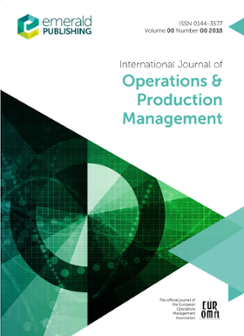How to empower analytics capability to tackle emergency situations?
IF 7.4
2区 管理学
Q1 MANAGEMENT
International Journal of Operations & Production Management
Pub Date : 2021-07-27
DOI:10.1108/ijopm-11-2020-0805
引用次数: 7
Abstract
PurposeAnalytics thrives in navigating emergency situations. Emergency operations management needs to develop analytics empowerment capability (ANEC) to prepare for uncertainty, support continuity and tackle any disruptions. However, there is limited knowledge on ANEC and its effects on strategic emergency service agility (SESA) and emergency service adaptation (ESAD) in such contexts. Drawing on the dynamic capability (DC) theory, we address this research gap by developing an ANEC model. We also model the effects of ANEC on SESA and ESAD using SESA as a mediator. We also assess the moderating and quadratic effects of ANEC on two higher-order DCs (i.e. SESA and ESAD).Design/methodology/approachDrawing on the literature on big data, empowerment and DC, we develop and validate an ANEC model using data from 245 service systems managers in Australia. The study uses the partial least squares-based structural equation modelling (PLS-SEM) to prove the research model. The predictive power of the research model is validated through PLSpredict (k = 10) using a training sample (n = 220) and a holdout sample (n = 25).FindingsThe findings show that analytics climate, technological enablement, information access, knowledge and skills, training and development and decision-making ability are the significant components of ANEC. The findings confirm strategic emergency service agility as a significant partial mediator between ANEC and emergency service adaptation. The findings also discuss the moderating and quadratic effects of ANEC on outcome constructs. We discuss the implications of our findings for emergency situations with limitations and future research directions.Originality/valueThe findings show that building ANEC plays a fundamental role in developing strategic agility and service adaptation in emergency situations to prepare for disruptions, mitigate risks and continue operations.如何赋予分析能力以应对紧急情况?
目的分析在应对紧急情况中发挥重要作用。应急运营管理需要开发分析授权能力(ANEC),为不确定性做好准备,支持连续性并应对任何中断。然而,在这种情况下,关于ANEC及其对战略应急服务敏捷性(SESA)和应急服务适应性(ESAD)的影响的知识有限。利用动态能力(DC)理论,我们通过开发ANEC模型来解决这一研究空白。我们还使用SESA作为中介来模拟ANEC对SESA和ESAD的影响。我们还评估了ANEC对两个高阶dc(即SESA和ESAD)的调节和二次效应。设计/方法/方法借鉴有关大数据、授权和DC的文献,我们使用来自澳大利亚245个服务系统经理的数据开发并验证了ANEC模型。采用基于偏最小二乘的结构方程模型(PLS-SEM)对研究模型进行了验证。使用训练样本(n = 220)和保留样本(n = 25),通过PLSpredict (k = 10)验证了研究模型的预测能力。研究结果表明,分析氛围、技术支持、信息获取、知识和技能、培训和发展以及决策能力是技术创新的重要组成部分。研究结果证实,战略应急服务敏捷性是ANEC与应急服务适应之间的重要部分中介。研究结果还讨论了ANEC对结果结构的调节效应和二次效应。我们讨论了我们的发现对有局限性的紧急情况的影响和未来的研究方向。独创性/价值研究结果表明,在紧急情况下,建立ANEC在发展战略敏捷性和服务适应性方面发挥着根本作用,为中断做好准备,减轻风险并继续运营。
本文章由计算机程序翻译,如有差异,请以英文原文为准。
求助全文
约1分钟内获得全文
求助全文
来源期刊
CiteScore
13.30
自引率
17.20%
发文量
96
期刊介绍:
The mission of the International Journal of Operations & Production Management (IJOPM) is to publish cutting-edge, innovative research with the potential to significantly advance the field of Operations and Supply Chain Management, both in theory and practice. Drawing on experiences from manufacturing and service sectors, in both private and public contexts, the journal has earned widespread respect in this complex and increasingly vital area of business management.
Methodologically, IJOPM encompasses a broad spectrum of empirically-based inquiry using suitable research frameworks, as long as they offer generic insights of substantial value to operations and supply chain management. While the journal does not categorically exclude specific empirical methodologies, it does not accept purely mathematical modeling pieces. Regardless of the chosen mode of inquiry or methods employed, the key criteria are appropriateness of methodology, clarity in the study's execution, and rigor in the application of methods. It's important to note that any contribution should explicitly contribute to theory. The journal actively encourages the use of mixed methods where appropriate and valuable for generating research insights.

 求助内容:
求助内容: 应助结果提醒方式:
应助结果提醒方式:


